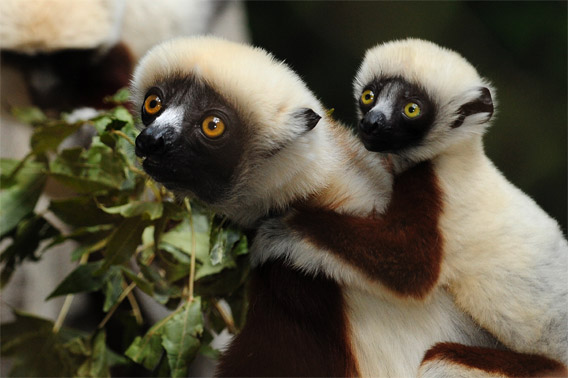The Wildlife Conservation Society’s Bronx Zoo today announced the birth of an endangered Coquerel’s sifaka, a type of lemur native to the island of Madagascar. The baby boy lemur is named Ares and becomes one of 51 sifaka kept in captivity worldwide.
While sifakas are generally found in trees where they are capable jumpers and feed on fruit, flowers, wood, bark and leaves, they are best known for their mode of “dancing.” Since trees in their habitat are often dispersed, sifakas cross open ground by sashaying on their hind legs with arms aloft.

Ares with mother Kate. Photo by Julie Larsen Maher ©WCS
Sifakas also have the remarkable ability to leaping from tree to tree in Madagascar’s unique spiny forest where virtually every branch is covered with thorns or spines. How they manage to do this without injuring themselves remains a mystery.
Sifakas generally live in groups of 3-13 individuals — the average group size is around 6 — consisting of roughly equal numbers of adult males and females, and several young.
Ares — along with his mother and father and other sifakas — is currently on display at the zoo’s Madagascar! exhibit.
Related articles
Dancing lemur attracts tourists to island of Madagascar
(05/30/2005) In the dry deciduous forests of south western Madagascar there lives a lemur that loudly cusses but “dances” like a ballet performer. Verreaux’s sifaka is among the most popular of lemur species, a group of primates endemic to islands off the southeastern coast of Africa. While threatened, Verreaux’s sifaka is easily spotted is several of Madagascar’s more accessible parks.